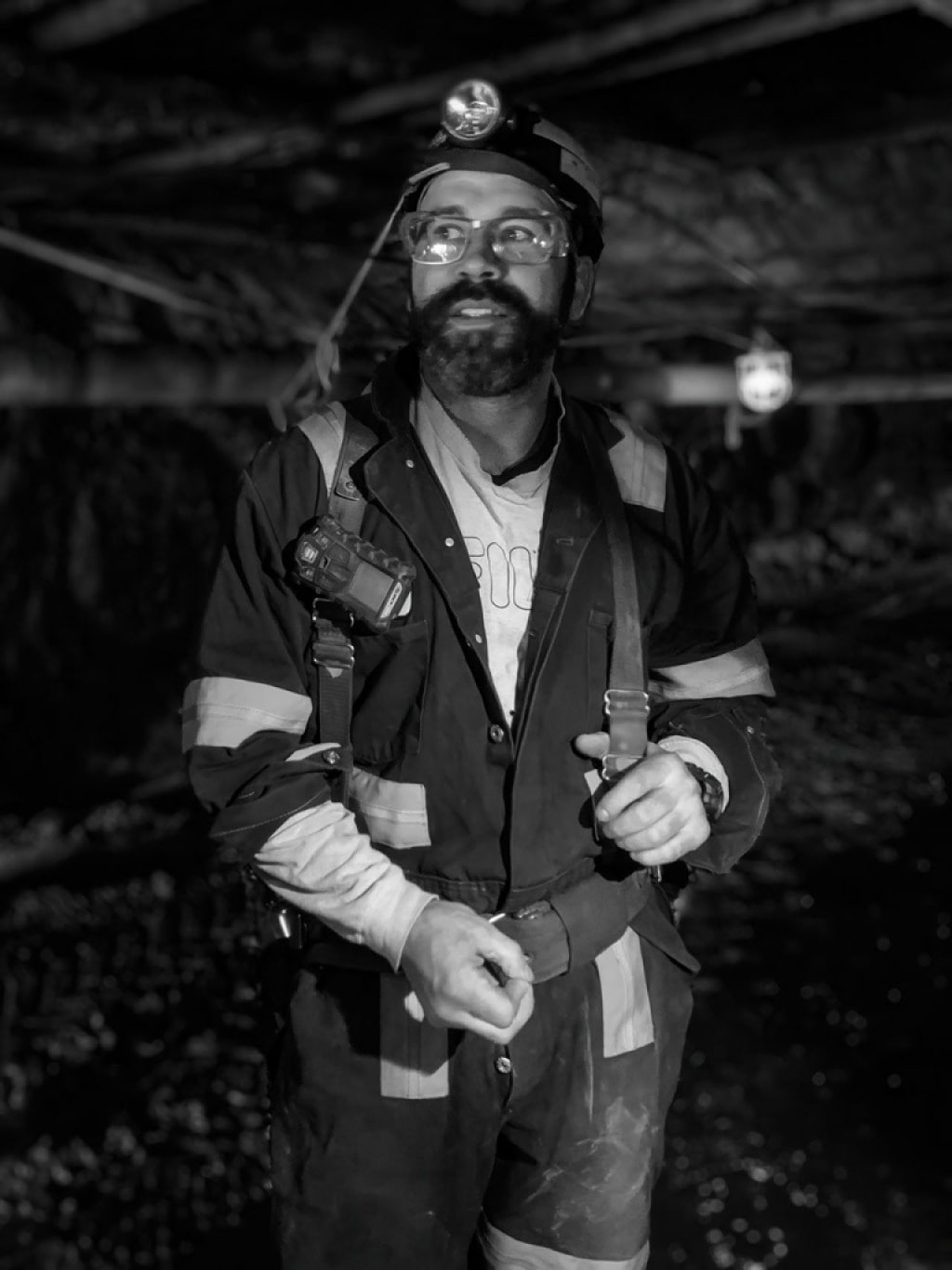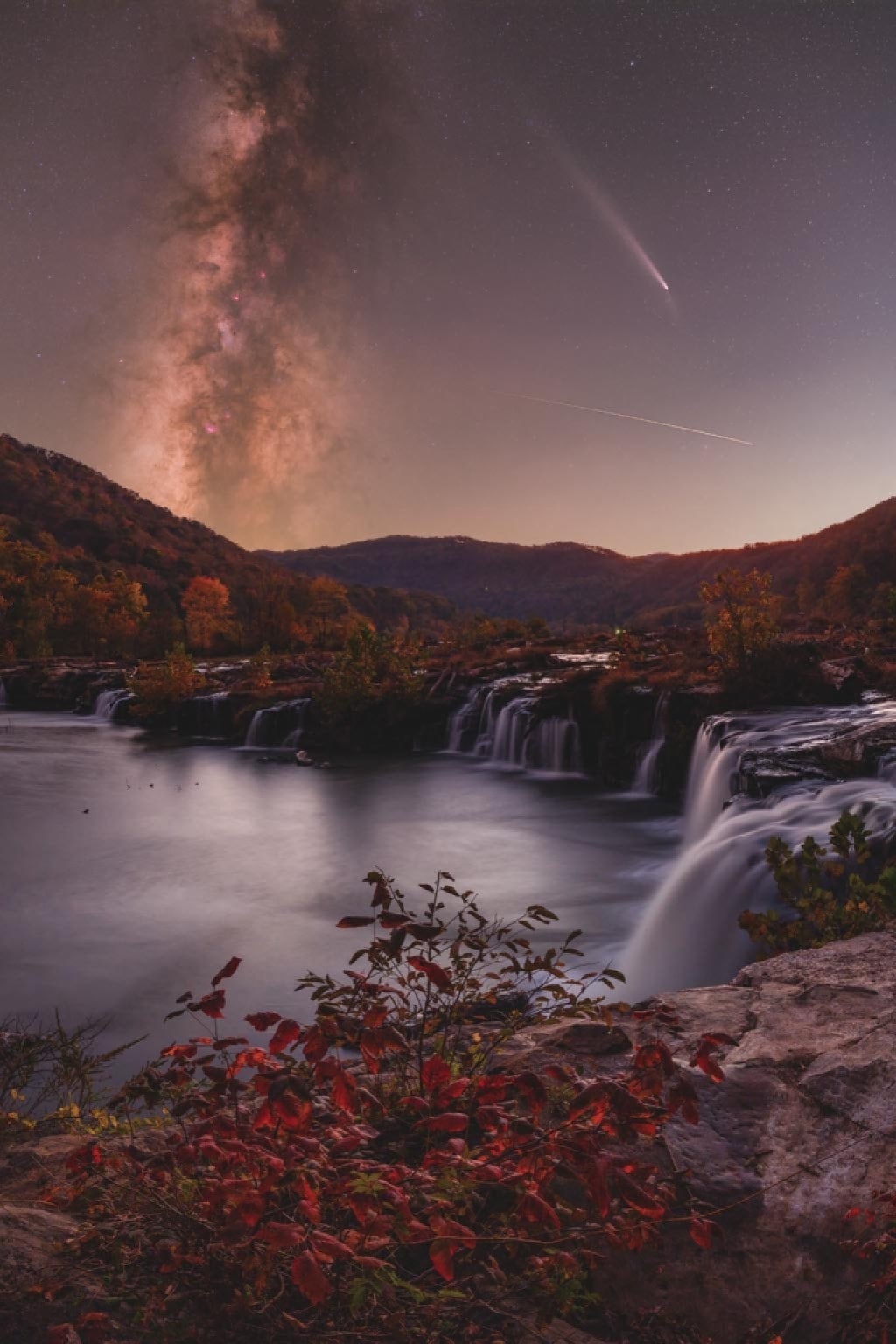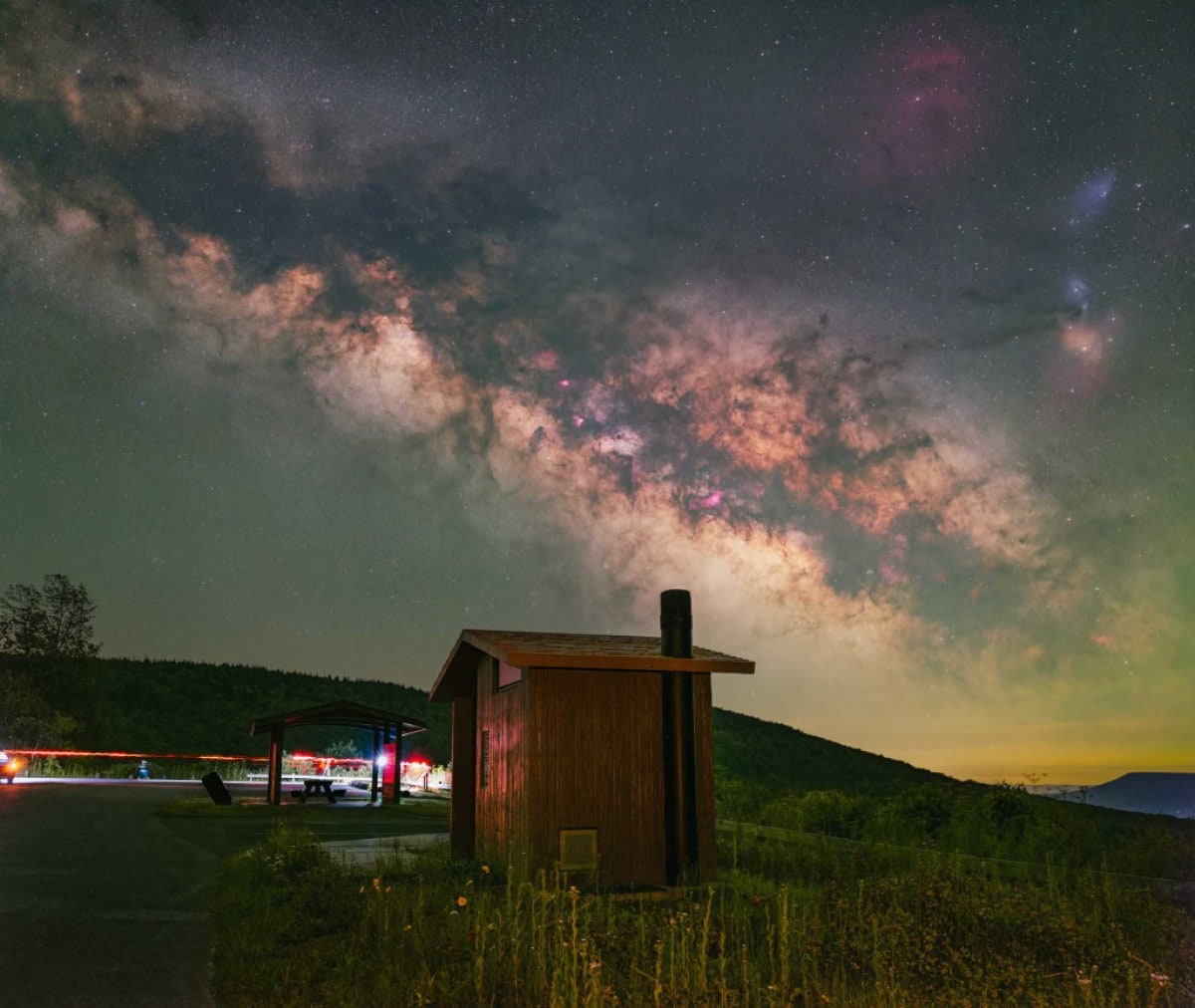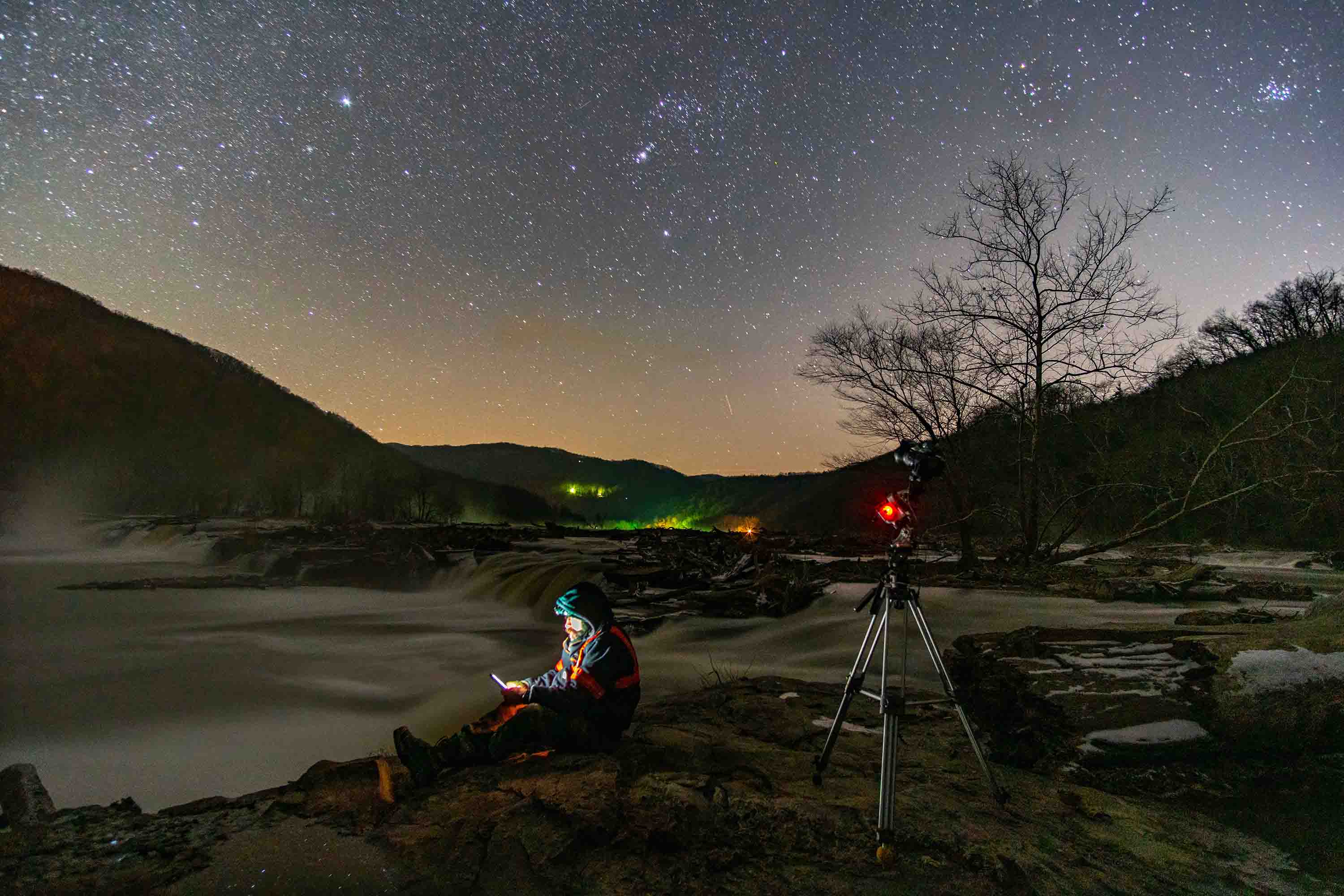A heavily bundled Dave Green gazed through his pickup’s frosted windshield into the silent West Virginia night, at the massive, eerily illumined Robert C. Byrd Green Bank Radio Telescope. He glanced at his laptop, which showed a time-elapsed image of the 100-yard-wide dish surrounded by snow-dusted fields set against dark green conifers and the undulating Allegheny Mountains. Iridescent, Milky Way stars fanned across the sky like a tapestry. The constellation Orion smoldered in the upper left corner.
“It was 3am, but I felt wide awake,” says Green, reflecting on that night in 2021. “It was solemn, stunningly beautiful. Part of me was like, ‘Have you lost your mind? It’s negative 5° outside and you’re staying up all night to take pictures of the sky for fun?’ But the biggest part of me was just so awed and grateful to be there seeing what I was seeing.”
Green had spent months studying star maps and weather patterns, waiting for the perfect photo opp. He arrived just before sunset to set up his gear. His camera perched atop a tripod, its wide-angle lens aimed slightly upward and left of the famed deep-space telescope. Green sat in the truck, cozied under an REI Co-op Magma 15 sleeping bag with a laptop and remote control, while an automated star tracker device adjusted his camera’s position to snap hundreds of long-exposure shots until sunrise. Later, he used editing software to manually weave hundreds of photos into a composite image that showcases the enigmatic beauty of Orion setting over the telescope throughout the night.
“A lot of astral photographers focus on [isolated celestial objects],” says Green, whose night sky photography has been featured by the likes of NASA and the National Park Service, and shown in art galleries across his home state of West Virginia. However, Green’s goal is to create images that capture the awe-inspiring experience of gazing up into the night sky from a point of reference that he says, “for me, feels equally mysterious and incredible.”
Green shoots almost exclusively in West Virginia, and he calls his work a “celebration of the beautiful wild spaces I grew up surrounded by, but didn’t fully appreciate until I was much older.”
Green’s journey to prominence as a night sky photographer began on the cusp of middle age—and totally by accident.
Growing up outside West Virginia’s 70,000-acre New River Gorge National Park and Preserve, Green spent most of his childhood afternoons and weekends hunting, fishing and playing in the nearby expanse of forests, streams and mountains. Reading the work of astronomer and planetary scientist Carl Sagan inspired a deep fascination with starry night skies. That led him to seek out and devour more books and documentaries about space.
Green’s family wasn’t wealthy and didn’t do a ton of traveling, “so, while I recognized I lived in a beautiful place with amazing starry skies, I didn’t really have anything to compare it to,” he says. “It took me decades to grasp and appreciate that access.”
Childhood passed; Green married and became a young parent. Confronted by adult responsibilities, he looked for a career. Virtually everyone he knew worked in or around coal mines, so he chose to take advantage of those connections. A decade later, his work ethic and knack for technology helped him earn a position with a regional mine safety team.

Life chugged comfortably along. Then Green’s boss threw him a curveball, asking him to create safety training videos for mine personnel—and the seemingly oddball request sparked a new purpose.
“It was strange because, for one, I didn’t consider myself a visually creative person at all,” he says. Now Green was tasked with making instructional films about, say, how to activate emergency fire suppression systems or properly wear a respiratory device. And the thing was, “I had zero experience with digital cameras or editing software.”
But, a gig’s a gig, and he was determined to produce quality results (see: that diehard work ethic). A natural tinkerer, Green set about learning photography’s nuts and bolts. He explored camera settings, asked questions in online forums, watched countless tutorials and tracked down local pros for tips. Relentless experimentation yielded incremental improvements.
“I stunk, but I could see I was getting better, and that was unexpectedly exciting,” says Green. He especially enjoyed snapping stills of workers for posters or videos. “Yeah, the work was cheesy, but I was really enjoying myself. I started thinking, ‘What if I try to push the envelope and get a little more creative?’”
The revelation led Green to try his hand at photographing other things: portraits of his wife and kids, action shots at sporting events, snaps of wildlife along hiking trails and more. A buddy at the gym heard about this new hobby and introduced Green to night sky photography. Green was moved as he swiped through photos on social media filled with scenes of constellations blazing like bright smoke, strewn across black, star-peppered skies.
“I was like, ‘Holy cow, this is the coolest thing I’ve ever seen. I’ve got to try this,’” says Green. He picked his friend’s brain, got a basic overview, then ventured out into the night to capture time-elapsed photos in dark, remote locations like Droop Mountain Battlefield State Park. He set up on hilltops or in secluded landscapes overhung with rapturous eruptions of stars. Shutters clicked, and Green watched his backscreen in amazement.

“That awe and wonder I’d felt as a kid came rushing back,” he says. “That’s when I knew this was going to be a major part of my life.”
Green returned home and threw himself into a whirlwind of research. He learned about crucial gear like DSLR cameras, star tracking heads, light painting equipment, denoising software and wide-aperture lenses—then found affordable used models on websites like eBay. Apps like Dark Sky Map helped him scout locations with low to no light pollution; Stellarium taught him to identify celestial objects and when and where they would appear in the night sky.
Green began targeting astrological events, planning images weeks or months in advance. He obsessed over weather patterns, watching for ideal windows to shoot. Most weekends and vacation days revolved around photos, and he developed his own unique style of astral photography.
“I like to feature familiar natural landmarks but place them in the framework of an astrological event unfolding across the night sky,” says Green.
Take his composite “Seneca Cygnus,” for example, shot in the Spruce Knob–Seneca Rocks National Recreation Area. First, a 2-mile hike to the summit of the park’s namesake 1,568-foot rock formation, to scout the perfect location for photographing it at sunset. Next, lugging 60 pounds of gear into a roadside field about a half mile west of the summit. Green took time-elapsed photos of the grass and cliffs as the sun dipped below the horizon. The images were later stitched together with hundreds of others snapped throughout the night. The result features a gravel road that curves through vibrant, spring-green grass toward ghostly stands of white sycamore, dark green hemlock and the jagged, chimney-esque rock formation. The cliffs are bathed in an otherworldly pink glow and jut into a vast, three-dimensional sky strewn with nebulae that hang like fiery clouds of dust and ember.
“My goal is to anchor my work in a sense of human perspective,” says Green, who’s been an REI Co-op Member since 2015. In doing so, he invites viewers to experience the miraculous overlap of micro and macro, the timeless wonder of contemplating the unfathomable cosmos from terra firma.
Friends and family initially considered Green’s all-night photography hobby a bit nutty, but when he started to share the results, their tune quickly changed. The resoundingly positive reaction pushed him to create dedicated social media pages and a website in early 2020.
“I didn’t think it would do anything,” says Green. But what was the worst that could happen?
Follows and likes trickled in along with requests to purchase prints. Then national stargazing pages and agencies like NASA began to feature and repost images. Local and regional galleries discovered Green’s work and reached out about exhibitions. Photography clubs and state parks invited him to lead night sky workshops, which are currently in the planning stages.
“The response took me completely by surprise,” says Green. “It feels kind of surreal, but I’m stoked to be able to play a small role in introducing people to the beauty of this region and hopefully highlighting the importance of preserving it for future generations.”

Green doesn’t foresee his work shifting away from West Virginia any time soon. He says the state is home to the best and most abundant dark sky viewing opportunities east of the Mississippi River, and he hopes to raise awareness around that.
“This is one of the few places in the eastern U.S. where you can drive 15 minutes from just about anywhere and find world-class star viewing,” says Green. And that’s especially true for the eastern mountain regions. “I take [visiting photographers] out and they’re blown away,” he says. “They can’t believe what they’re seeing.”
Looking back, Green chuckles at the irony of his artistic journey—how a seemingly farcical assignment opened the door to a life-changing passion. The fact that others dig the results? That’s just icing on the cake.
“I never thought I’d become a photographer, much less totally reorient my life around it, but here I am,” he says. “I just feel so profoundly grateful to have found a way to express the love and admiration I feel for this amazing corner of the planet.”
How to Take Night Photos Like a Pro
Here are some of REI Co-op Member Dave Green’s tricks to help you explore night photography (without breaking the bank). Peruse his art, buy prints and learn more at his website, dave-has-a-camera.com.
You can also learn more by reading Photographing Stars at Night and Headlamp Painting: Illuminate Your Nighttime Photos.
Start Simple
With so much info available online, it’s easy for beginners to get bogged down in the high-tech elements of night sky photography. “You start doing research and it gets into the scientific weeds pretty quick,” says Green. Furthermore, “everywhere and everyone is trying to push you to buy expensive, high-end gear.” It can be discouraging.
Instead, Green urges novices to start with a basic setup and see what happens. His early-outing toolkit included no more than a basic, hand-me-down Canon Rebel, cheap wide-angle lens and used tripod.
“That’s all you really need,” says Green. He’s taken newbs out with that setup, “and they’re blown away by what they can capture.”
Timing Photos and Finding Spots
You don’t need to drive a million miles or hoof it into swamp-thick backcountry darkness to get a decent image. In fact, Green says it’s more about orientation and quality conditions than location.
Start by checking the moon cycle and looking for a night when it’s a new moon. Then use a weather app to find a couple-hour window of clear skies. Consult a website like Dark Sky Map to identify a spot near you that’s within reasonable distance and offers comparatively dark and unobstructed southward views.
On clear, moonless nights during July, says Green, “you can drive 15 minutes from a major source of light pollution just after sunset, aim away from it toward the southern sky and capture the rising Milky Way core.”
Tweak Your Basic Setup
When you arrive at the shooting location, position your tripod and camera so the lens is pointed away from all light sources. Firmly securing the camera to the tripod will ensure it doesn’t shake and distort your images.
Adjust your lens to the widest viewing angle possible (preferably one lower than 24). Set your exposure between 20 to 30 seconds, your f-value or aperture (the opening in a photographic lens that lets in light) between 1.4 and 2.8 (or the lowest available number), and the ISO (your camera’s light sensitivity) to 3200 or 6400. Use the camera’s timer to trigger the shutter and avoid wobbles.
Follow this advice and “you’re sure to get something pretty cool,” says Green. And if you love the experience? “Then you can start thinking about ramping things up from there.”

